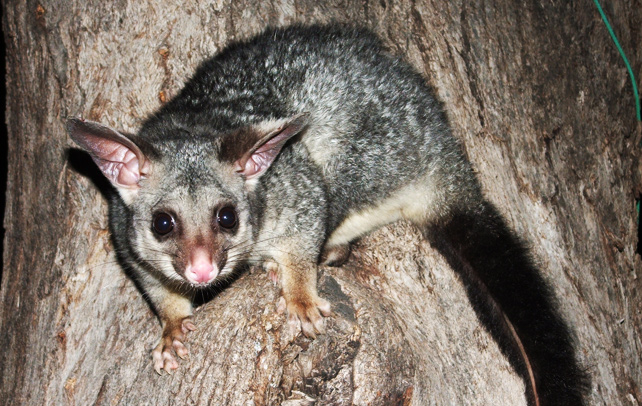Interesting Information On Opossums

The opossums are the only marsupials found in North America. Marsupial, an infraclass of mammals, suggests that the infant opossum resides in the pouch of adult female opossum. Opossums have marked their presence since the time of dinosaurs; the fossils of opossums are found to be 70 million years old! They are of varying sizes and weights. They usually have whitish face, grey fur body, naked ears, and a flaking tail. An opossum looks like an overgrown rat; however, the existence of the two does not coincide with each other. Nature of opossums can be very well linked with that of cats, as both exhibit habits of cleanliness and believe in grooming themselves. Here, we are presenting you the most interesting and amazing facts about them. Read out the next section to gain a wider insight into the facts and figures of opossum.
Fast Facts
Scientific Name: Didelphis Virginiana
Kingdom: Animalia
Phylum: Chordata
Class: Mammalia
Order: Didelphimorphia
Family: Didelphidae
Infraclass: Marsupialia
Species: More than 103
Shape: Possum
Origin: Western Hemisphere
Diet: Omnivorous
Size: 15 to 20 inches long
Weight: 4-6 kg
Teeth: 50
Life Span: 2 to 4 years
Natural Habitat: hollow logs, rock crevices, pipes, attics, and beneath buildings.
Call: Adult: Smack noise; Young: Sneezing or hissing
Gestation Period: 12 to 14 days
Number of Offspring: Nearly 20 litters (vary from species to species)
Interesting Information On Opossums
- Amazingly, opossum comes from the oldest surviving mammal family.
- Out of the 60 different species of opossum existing on the earth, Virginia opossum is the one widely seen and is the only pouched mammal in Canada and the United States.
- The competent immune system and low body temperature of an opossum keeps it protected from viruses like rabies.
- The paws of an opossum are very soft like a human hand, so they do not tend to dig holes.
- The colour of opossum’s fur can range from white and cinnamon to black. Most commonly it is grey-coloured.
- Opossums are usually calm in nature. They dribble, growl, and show all their teeth when scared.
- Opossum exhibits ‘playing possum’ to protect itself in frightful situations. It goes in the stage of involuntary coma when the rescue becomes impossible. This stage of coma may continue from 40 minutes to 4 hours.
- Opossum does not stay at the same place for a long period. On an average, it spends 2 to 3 days at one place and then shifts to next place.
- Opossum is known to enjoy its loneliness.
- An excellent tree climber, opossum uses its sharp claws, tail, and mouth to climb.
- Its good sense of smell helps in food hunt.
- Opossum lacks good vision and does not have strong hearing abilities.
- The infant opossum, as small as a honeybee, resides in the pouch of the mother opossum and gets developed there.
- An opossum is capable of giving birth to nearly twenty baby opossums in a litter; however, most of them do not survive for long.
- The most favourite abode of an opossum is in the tree holes and sometimes, in the den of other animals.
- An opossum is opportunistic in nature and it survives on whatever it finds as food. The range of eatables includes insects, snails, berries, over-ripe fruits, grasses, leaves, and carrion. They are also seen eating snakes, ground eggs, and corns sporadically.
- It is one of the mammals embraced with high adaptability. Water, food, and shelter are the only prerequisites for its stay at one place.
- Sometimes the young opossums hang from trees using their tails. Adult ones use their tails in climbing, which supports them as a fifth limb.
- Mexicans call opossums as “tlacuache” or “tlaquatzin” and intake their tails as a conventional remedy to improve fertility.









